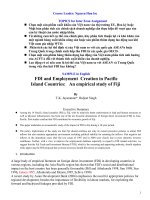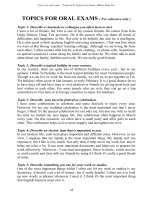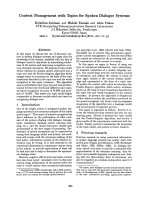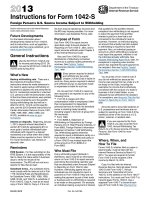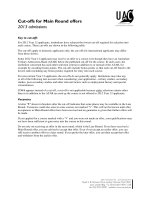TOPICS for Inter Econ Assignment 2013
Bạn đang xem bản rút gọn của tài liệu. Xem và tải ngay bản đầy đủ của tài liệu tại đây (222.49 KB, 8 trang )
Course Leader: Nguyen Huu loc
TOPICS for Inter Econ Assignment
Chọn một sản phẩm xuất khẩu của Việt nam vào thị trường EU, Hoa kỳ hoặc
Nhật bản phân tích các chính sách doanh nghiệp cần thực hiện để vượt qua rào
cản kỷ thuật của nước nhập khẩu.
Từ những cam kết cụ thể của chính phủ, hãy phân tích thuận lợi và khó khăn của
một ngành hàng xuất khẩu nông sản hoặc sản phẩm thâm dụng lao động sau khi
Việt nam gia nhập WTO.
Phân tích các lợi thế định vị của Việt nam so với các quốc gia ASEANs hoặc
Trung Quốc trong chính sách hấp thu FDI từ các quốc gia OECD.
Chọn một sản phẩm hàng thâm dụng lao động của Việt nam phân tích ảnh hưởng
của ACFTA đối với thành tích xuất khẩu của doanh nghiệp.
Lao động rẻ có nên xem là lợi thế của Việt nam so với ASEAN và Trung Quốc
trong việc thu hút FDI hay không?
SAMPLE in English
FDI and Employment Creation in Pacific
Island Countries: An empirical study of Fiji
By
T.K. Jayaraman* Baljeet Singh
Executive Summary
Among the 14 Pacific island countries (PICs), Fiji, with its relatively better endowments in land and human resources as
well as physical infrastructure, has been one of the ten favourite destinations of foreign direct investment (FDI) in Asia-
Pacific. Past studies confirm that FDI contributed to economic growth of Fiji.
This paper undertakes an econometric study of the impact of FDI in Fiji during a 30-year period.
The policy implications of the study are that Fiji should continue not only its current proactive policies to attract FDI
inflows but also maintain appropriate environment including political stability for retaining the inflows. Past negative net
inflows in the immediate years after the two coups of 1987 and in 2000 were clearly due to poor domestic investor
confidence. Further, with a view to improve the employment database especially in regard to FDI related activities, we
suggest that the Fiji Trade and Investment Bureau (FTIB), which is the screening and appraising authority, should stipulate
while approving the FDI proposal that overseas investors should file returns on employment
1. Introduction
A large body of empirical literature on foreign direct investment (FDI) in developing countries in
various regions, including the Asia-Pacific region has shown that FDI’s social and distributional impact
on the host country has been generally favourable (Hill and Athukorala 1998, Sun 1998, Sun 1996,
Jansen 1995, Athukorala and Menon,1995, Schive 1990)
A recent study by Asian Development Bank (2004) emphasizes the need for appropriate policies for
regional development, besides the importance of flexibility in labour markets, for exploiting the
forward and backward linkages provided by FDI.
1
Our paper focuses on the Pacific island countries (PICs)1. The objective of this paper is to undertake an
empirical study on creation of employment opportunities by FDI in Fiji. The choice of Fiji, as case
study, is dictated mainly by data constraints relating to availability of reliable time series of a longer
period compared to other PICs.
The paper is organised on the following lines: in section 2, trends in FDI and employment in Fiji are
reviewed; section 3 deals with the data and methodology adopted for the empirical study, while section
4 presents the results of the study; and the final section 6 lists some conclusions with policy
implications.
2. Literature review
Among PICs, Fiji, Solomon Islands and Vanuatu have been attractive countries for FDI for past
two decades. All the three PICs were among the top 10 destinations for FDI in developing Asia-
Pacific region (Table 1).
Table 1: Top 10 Destinations for FDI in Developing Asia: 1991-1993 and 1998-2000
( Average Inflows per capita in US$)
Insert Table1 here
Source: Asian Development Bank (2006)
Past trends
The term FDI would normally refer to substantial equity stake and effective control of
enterprises. However, in the context of growing services sector in developing countries, a
broader definition seems to have been emerging. This now refers to non-equity participation by
foreigners by way of licensing, franchising, joint ventures with limited equity participation and
R&D cooperation (de Mello 1997).
In FDI approach, most of the FDI inflows to PICs in the past were primarily of the natural
resource exploiting type. These natural resource based FDI inflows were later on followed in the
1980s by FDI in export-oriented, labour intensive garments and other industries due to deliberate
policies (Jayaraman and Choong 2005, Gani 1999). The third type of investment, known as
market seeking, was mainly limited to retail trade, as the populations of PICs were small.
Table 3 provides FDI flows to Fiji in US million dollars during the recent period (1985-2002) as
well as in percent of GNP. The stock of FDI in 2002 is reported to be US$1,211 million, which
is around 66% of GNP (United Nations Conference Trade and Development 2006). The FDI
flows were highly susceptible to political conditions as evidenced by their decline soon after the
1987 and 2000 coups.
Table 3: FDI Inflows to Fiji : 1985-2002
(U$ Million and % of GNP)
Source: World Bank 2006a
3. Data and Methodology
The estimation procedure of the empirical study, which covers a 34-year period (1970-2003), is
constrained by data inadequacies4.
2
Data : as noted by a recent study (Asian Development Bank 2004), accurate estimates of FDI stock are
rarely available in the Asia-Pacific region. One has to depend upon the FDI net inflow data, despite the
fact that they are poorly recorded.
Modeling and methodology : we hypothesize that annual employment is positively associated with
annual FDI inflows. Since annual employment is also dependent on economic growth, we also
hypothesize that employment in FDI activities is also directly influenced by gross domestic product
(GDP).
4. Result of Study
Unit root test : our first step was to investigate the unit root properties of the data series. Although it is
recognised that the knowledge on the integrational properties is not required for the application of the
bounds test, it is a crucial step in ensuring that we obtain an unbiased estimation from the Granger
causality tests.
Cointegration : Our next aim is to investigate whether Y, FDI and L share common long-run
relationships. To achieve this, as explained earlier, we test for the presence of long-run relationships in
Equations (1)-(3).
Long-run estimates : Having found the existence of a long run relationship in the Equation with L as
dependent variable and FDI and GDP, as explanatory variables, we now proceed to estimate the long
run marginal effect.
5. Conclusion and Policy Recommendation
The paper investigated the relationship between employment and foreign direct investment for Fiji
through a multivariate modeling strategy by including GDP. We proceeded in four steps. First, we
subjected the data series –real GDP, real foreign direct investment net inflows and employment – to
ADF tests in order to ascertain the nature of stationarity properties of the variables.
We found that there were two cointegration relationships among the variables when formal sector
employment and GDP were the endogenous variables. This finding paved the way for estimating
marginal effect on the impact of foreign direct investment and GDP on employment, which we
investigated in the third step.
Based on the findings of the study, we recommend that Fiji should continue not only its current
proactive policies to attract FDI inflows but also maintain appropriate environment including political
stability for retaining the inflows.
Referrences
Asian Development Bank (ADB), 2005. “Special Chapter on Labour Markets in Asia:
Promoting Full, Productive and Decent Full Employment”, Key Indicators 2005, Manila; ADB.
ADB (2004). “Foreign Direct Investment in Developing Asia”, Part 1,Asian Development
Outlook, 2004, , Manila; ADB.
Athukorala, P. and J.Menon (1005). Developing with Foreign Investment in Malaysia”, The
Australian Economic Review, Ist Quarter, 9-22.
Atkins, F.J. and Coe, P.J. (2002). “An ARDL Bounds Test of the Long-Run Fisher Effect in the
United States and Canada”, Journal of Macroeconomics, 24, 255-266.
3
De Mello, Jr., L.R., (1997) “Foreign Direct Investment in Developing Countries: A Selective
Survey”, The Journal of Development Studies, 34 (1): 1-34.
Elek, A., H. Hill, and Tabor, S., (1993). “Liberalization and Diversification in a Small Island
Economy: Fiji since the 1987 Coups”, World Development, 21(5): 749-769.
Engel, R.F. and Granger, C. W. J., (1987) Cointegration and Error Correction Representation,
Estimation and Testing. Econometrica, 55, 251-276.
Gosaraevski, S., H. Hughes and S. Windybank, (2004). The Pacific is Viable, Issue Analysis
No.43, Canberra: Centre for Independent Studies.
Hill, H. and Athukorala, P. (1998). “Foreign Investment in East Asia”, Asia-Pacific Economic
Literature, 12(2): 23-50.
Hughes, H., (2003). Aid has Failed the Pacific, Issue Analysis No.33, Canberra: Centre for
Independent Studies
Jansen, K.(1995). “The Macroeconomic Effects of Direct Foreign Investment: The Case of
Thailand”, World Development, 23(2): 183-210.
Jayaraman, T.K. and Choong, C.K. (2006). “ Foreign Direct Investment in the South Pacific
Island Countries: A Case Study of Fiji”. World Review of Entrepreneurship, Management and
Sustainable Development, 2 (4), 309-322
Sun, H.(1998). “Macroeconomic Impact of Direct Foreign Investment in China: 1979-1996 ”,
The World Economy, 21(5): 675-694.
World Bank (2006a). Global Development Finance 2006 Volume 2: Country Tables,
Washington, D.C: World Bank.
World Bank (2006b). World Development Indicators 2006, CD-ROM, Washington, D.C. : World Bank.
Acceptale Structure
Đề tài Từ các cam kết cụ thể giữa Việt nam và WTO, dùng lý
thuyết hội nhập phân tích thuận lợi và thách thức ngành sản xuất
Thép trong nước sau khi gia nhập WTO.
BY
Nguyễn….& Howard….
4
Tóm tắt bài viết
• Tóm lược viết khoảng 100 từ
• Viết thành một paragraph
• Những khám phá chính/đóng góp của tác giả
• Từ khóa của bài viết
Thí dụ:
“Bài viết nầy sẽ dùng P Pháp … Để tim …
Các chính sách khuyến nghị gồm…”
I Giới thiệu
• Mục đích của bài viết : Giải quyết các vấn đề về ngành sản xuất và xuất khẩu
thép ở Việt Nam đang phải đối diện như….
• Làm rõ những gì mà các tác giả khác làm và những gì mà tác giả dự kiến làm. Thí
dụ “Các bài viết trước đây (past studies) only đề cập ….Trong khi thép là sản
phẩm phụ thuộc nhiều vào nguyên liệu nước ngoài vẩn chưa thấy có tác giả nào
chú trọng…..”
• Ý nghĩa của việc nghiên cứu (significances): Tầm quan trọng của vấn đề nghiên
cứu (khái quát hóa). Tại sao lại chon đề tài này ? (thép là ngành công nghiệp xuất
khẩu có kim ngạch lớn nhưng phụ thuộc nhiều vào nguyên liệu nhập khẩu từ Nga
và Trung Quốc or Tranh luận đang gay gắt hiện nay là chính phủ có nên hồ trợ
doanh nghiệp thép trong nước không? Or tác giả cần làm rỏ các tranh luận hiện
nay ở Quốc hội Or something like that.
+ Giới hạn nghiên cứu: Thí dụ từ 1993-2008, và chỉ xét vùng Đông Nam Bộ,….do số
liệu thu thập hạn chế
+ Phương pháp nghiên cứu: (empirical or non-empirical)
• Thống kê mô tả (sử dụng với kiểm định chi–squared): Sử dụng bảng thống kê một
chiều, hai chiều, ba chiều…để trả lời các câu hỏi nghiên cứu bằng số liệu và đưa
ra các kết quả sơ bộ (xu thế, tương quan, cơ chế vận hành). Mục tiêu là kiểm định
sơ bộ giả thiết nghiên cứu
• So sánh (before after approach)
• Phân tích tương quan, ma trận tương quan và ý nghĩa thống kê.
• Phân tích hồi quy (Regression analysis)
• Phân tích chuỗi thời gian (ARIMA)
• Mô hình hóa (modeling approach)
• Phân tích thành tố (Factor analysis)
• Điều tra (survey)
• SWOT, PEST,
5
